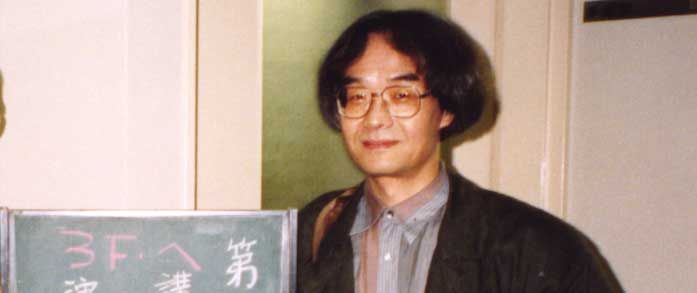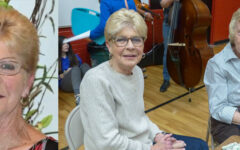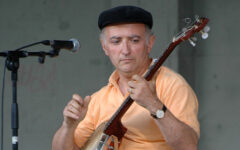
This remembrance of Japanese bluegrass artist and scholar Toru Mitsui is a contribution from Neil V. Rosenberg, Professor Emeritus in the Department of Folklore at the Memorial University of Newfoundland. It will also appear in Japan’s Moon Shiner magazine.
Toru Mitsui died on February 19, 2023. He was 82. Born on March 31, 1940, in Saga, Kyushu, son of a University of Kyushu professor of English, his life in music began early. While studying at Seinan Gakuin University in Fukuoka, he played lead electric guitar in a Fukuoka dance band with fellow college students, doing rock and roll, country, Hawaiian, and contemporary pop. One of his bandmates was Tsuyoshi Hashimoto, a childhood friend with whom he’d long shared an interest in music. At University, they became attracted to American folk music. They even put together a bluegrass quintet, Kentucky Highland Folks, for a concert in 1961.
Toru followed this interest not only as a performer but also a scholar. His Batchelor’s (1962) and Master’s (1964) theses were about traditional English ballads. Following this training, he began his academic career as a lecturer at Aichi University in Nagoya. His performing continued as he conducted research and lecturing on Anglo-American folksong.
I met Mitsui in June 1966, soon after he arrived at Indiana University in Bloomington to study at the Folklore Institute where I had just become an employee. It was a pleasant surprise to discover that he knew so much about American folk music.
Mitsui and his wife, Takako, stayed in Bloomington until early 1967. I took him to Bill Monroe’s Brown County Jamboree in nearby Bean Blossom several times. He would later draw from his diary and photos to describe that experience in Moon Shiner. In August 1966, the Mitsuis traveled to the east coast, where they first attended a big folk festival in upstate New York, Fox Hollow. Next, they went to Greenwich Village in New York City to visit The Folklore Center and meet its legendary proprietor, Izzy Young. Finally, on Labor Day weekend they came to Cantrell’s Horse Farm in Fincastle, near Roanoke, Virginia, to join us at Carlton Haney’s second annual bluegrass festival. There they saw Bill Monroe, The Country Gentlemen, Don Reno, Red Smiley, Mac Wiseman, and many other famous bluegrass pioneers.
In the fall of 1967, his Bluegrass Music — the first book ever written about bluegrass — was published. It included photos from the Haney festival and Bean Blossom. When its revised edition appeared in 1975, Bill Monroe’s autographed endorsement, which he wrote for Toru while performing in Osaka, was on the title page.
In 1969, Mitsui moved to Kanazawa University, where he taught until his retirement in 2005. During his career he became one of the world’s leading scholars in the field of Popular Music Studies. He was a prolific writer, publishing over twenty books, forty academic papers, and close to 500 articles in commercial and independent journals. He also wrote notes for 135 LP and CD albums, and made sixty radio and television appearances. Moreover, he translated many books and articles.
His most important English book is Popular Music in Japan: Transformation Inspired by the West (New York: Bloomsbury, 2020). Its final chapter (7, p.149) gives a history of bluegrass in Japan, a reflection of his continuing love for this music.
Over the years we kept in touch by mail and email, met at academic conferences, and visited each other’s homes. Mitsui hosted my parents when they visited Kanazawa and later, during his visits to Berkeley, California, would stay with my father. In 1990, at a party celebrating my father’s 80th birthday, Toru suggested to me and my bandmates in the Redwood Canyon Ramblers, Northern California’s first bluegrass band (1959-63), that because we were the first bluegrass band Jerry Garcia heard, we might find an audience in Japan.
This led to our 1991 reunion tour of Japan. With the support of Sab and Toshio at BOM, Mitsui was the Redwood Canyon Ramblers’ manager, MC, and tour guide. We played 10 gigs, beginning in Kusu in O’ita on Kyushu, and ending in Kanazawa. A set at the Tokoshima Bluegrass Festival, where he introduced us, can be seen on YouTube. We were joined there by the great Dobro player Sato and bassist Ueda:
After his retirement he reunited with his old friend Hashimoto, releasing CDs of their 1960s folk and bluegrass performances, which received a good review in The Journal of American Folklore. In June 2007 they appeared at the IBMM’s ROMP festival. Their performance was reported on the front page of the Owensboro daily newspaper.
Toru Mitsui was truly one of a kind. He was an accomplished musician, outstanding scholar, and a very good friend. I’ll always remember his kindness, and the happy times we had together during our visits and travels. With this message I send Japanese bluegrass fans these thoughts of condolence: We grieve the loss of a unique friend, but can be happy that he left so much fine music and great writing for us to appreciate and continue to enjoy. That nurtures our memories.
R.I.P., Toru Mitsui.







